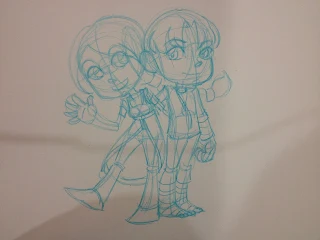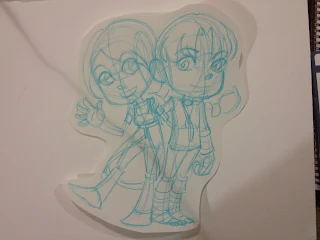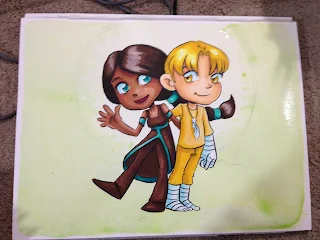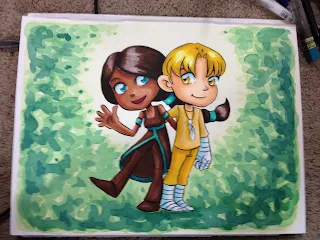Copic and Watercolor Mixed Media Tutorial
While cleaning up my Blog Stuff folder, I found some photos from a Copic and Watercolor commission I did last Christmas for Aisazia. I've mentioned using Copics and watercolors together several times, but I don't think I've ever done a step by step tutorial, so I think now is a great time to revisit those photos and make them into a post.
This illustration was done on 9"x12" Fluid watercolor paper. I believe I inked it with Kaimai Sol K ink, which is Copic-proof, but not entirely water proof (this is before I discovered the Sailor Mitsuo Aida),and was inked with a Creative Mark Rhapsody kolinsky sable brush from Jerry's Artarama.
Using watercolors with your alcohol based markers is a great way to extend a limited marker collection, preserve color saturation, and become comfortable with a new medium. I recommend starting with your markers first, and then proceeding to watercolors when you've finished applying your markers, but in theory, neither medium should disturb the other because the two have different solvents. Copics, Prismacolors, and other alcohol based markers use quick evaporating alcohol as their solvent, and watercolors use water as a solvent. This means that water won't disrupt the dyes in alcohol based marker inks, and theoretically, the alcohol won't disrupt the pigments used in watercolors. I can vouch that this technique works Copics to watercolor, but I don't promise that the reverse is true.
Step 1: Blueline Sketch
Step 2: Graphite Transfer onto Watercolor paper
Not shown: Applying graphite (I like to use 6B graphitee sticks) to the back of the sketch paper.
Step 3: Inks
Step 4: Copic
Aisazia kindly provided me with plenty of great reference for her characters, and I wanted to make sure I did them justice, so I did a lot of swatching to ensure I got the colors right.
As I'd mentioned in an earlier Copic tutorial, it's important to make swatches and keep notes about what colors work and which ones don't on a separate piece of paper. You can even reference combinations that worked out well for later use! Above are the skintones, blushes, and shading for both characters.
Swatches for the male character's hair.
Swatches for shading on the female character's outfit, and finding the right blue to serve as a shadow on the male character's bandages.
When you're entirely finished with your alcohol based markers, you can move on to watercolors. Copic and watercolor can be used together because water will not reactivate the dyes used in alcohol based markers. You might be able to do watercolor first, and later add Copic accents, but I don't recommend it, as the pigments used in watercolors might ruin the nibs of your alcohol based markers.
Copics and watercolor really suit each other because alcohol based markers are capable of very vibrant color, and the watercolor adds shadow and contrasting color without turning your original colors to mud.
Step 5: Watercolor
Now that I've laid in everything with my Copics, it's time to add shadow and a background. The client requested a leafy green background, so I lay in some yellow around the figures.
And I start blocking in leaves with a very light green.
Step 6: Background And Applying Shadow to Figures
For skin shadows, I like using a reddish violet for Caucasian skin, and a darker red violet for darker skintones. For a general shadow color, I used a mixture of Indigo and Payne's Gray.
And I used a pthalo blue with a green cast to it to add shadows to the leaves.
I used indigo for the very darkest leaf shadows, and added white gouache to the hair and painted his feather in, adding details with black ink later.
Introducing watercolor to your marker illustrations not only speeds up the process, but enables you to keep the bright, vibrant hues that markers are famous for. You can quickly apply shadow and background with watercolor, extending the life of your markers, and mixing the two media gives an more relaxed, organic feeling than working with marker alone.
This illustration was done on 9"x12" Fluid watercolor paper. I believe I inked it with Kaimai Sol K ink, which is Copic-proof, but not entirely water proof (this is before I discovered the Sailor Mitsuo Aida),and was inked with a Creative Mark Rhapsody kolinsky sable brush from Jerry's Artarama.
Using watercolors with your alcohol based markers is a great way to extend a limited marker collection, preserve color saturation, and become comfortable with a new medium. I recommend starting with your markers first, and then proceeding to watercolors when you've finished applying your markers, but in theory, neither medium should disturb the other because the two have different solvents. Copics, Prismacolors, and other alcohol based markers use quick evaporating alcohol as their solvent, and watercolors use water as a solvent. This means that water won't disrupt the dyes in alcohol based marker inks, and theoretically, the alcohol won't disrupt the pigments used in watercolors. I can vouch that this technique works Copics to watercolor, but I don't promise that the reverse is true.
Step 1: Blueline Sketch
Step 2: Graphite Transfer onto Watercolor paper
Not shown: Applying graphite (I like to use 6B graphitee sticks) to the back of the sketch paper.
Step 3: Inks
Step 4: Copic
Aisazia kindly provided me with plenty of great reference for her characters, and I wanted to make sure I did them justice, so I did a lot of swatching to ensure I got the colors right.
As I'd mentioned in an earlier Copic tutorial, it's important to make swatches and keep notes about what colors work and which ones don't on a separate piece of paper. You can even reference combinations that worked out well for later use! Above are the skintones, blushes, and shading for both characters.
Swatches for the male character's hair.
Swatches for shading on the female character's outfit, and finding the right blue to serve as a shadow on the male character's bandages.
When you're entirely finished with your alcohol based markers, you can move on to watercolors. Copic and watercolor can be used together because water will not reactivate the dyes used in alcohol based markers. You might be able to do watercolor first, and later add Copic accents, but I don't recommend it, as the pigments used in watercolors might ruin the nibs of your alcohol based markers.
Copics and watercolor really suit each other because alcohol based markers are capable of very vibrant color, and the watercolor adds shadow and contrasting color without turning your original colors to mud.
Step 5: Watercolor
Now that I've laid in everything with my Copics, it's time to add shadow and a background. The client requested a leafy green background, so I lay in some yellow around the figures.
And I start blocking in leaves with a very light green.
Step 6: Background And Applying Shadow to Figures
For skin shadows, I like using a reddish violet for Caucasian skin, and a darker red violet for darker skintones. For a general shadow color, I used a mixture of Indigo and Payne's Gray.
I used indigo for the very darkest leaf shadows, and added white gouache to the hair and painted his feather in, adding details with black ink later.
Introducing watercolor to your marker illustrations not only speeds up the process, but enables you to keep the bright, vibrant hues that markers are famous for. You can quickly apply shadow and background with watercolor, extending the life of your markers, and mixing the two media gives an more relaxed, organic feeling than working with marker alone.
































Comments
Post a Comment